The proposed infrared or IR remote control circuit can be used to operate an appliance ON/OFF through any standard TV remote control handset.
In this write up I will explain a couple of these simple infrared remote control circuits designed for controlling any given electrical appliance through an ordinary or TV remote control unit.
Introduction
Controlling household electrical gadgets or any electrical equipment remotely can be fun.
Controlling gadgets like a TV set or a DVD player through a remote may look pretty common to us and we are very used to with the experience, however for controlling many other domestic equipment like a water pump, lights etc we are compelled to walk around for implementing the switching.
The article is inspired by our usual TV remote concept and has been applied for controlling other house hold electrical appliances remotely.
The circuit facilitates and helps the user to do the operations without moving an inch from his resting place.
The whole circuit of the proposed IR remote control may be understood by studying the following points:
Referring to the figure, we see that the entire layout consists of just a couple of stages viz: the IR sensor stage and the flip flop stage.
Thanks to the highly versatile, miniature IR sensor TSOP1738 which forms the heart of the circuit and directly coverts the received IR waves from the transmitter unit into the relevant logic pulses for feeding the fllip flop stage.
The sensor basically consists of just three leads viz: the input, the output and the biasing voltage input lead. The involvement of only three leads makes the unit very easy to configure into a practical circuit.
The sensor is specified for operating at 5 volts regulated voltage which makes the inclusion of the 7805 IC stage important.
The 5 voltage supply also becomes useful for the flip flop IC 4017 and is appropriately supplied to the relevant stage.
When a IR signal becomes incident over the sensor lens, the inbuilt feature of the unit activates, triggering a sudden drop in its output voltage.
The PNP transistor T1 responds to the negative trigger pulse from the sensor and quickly pulls the positive potential at its emitter to the collector across the resistor R2.
The potential developed across R2 provides a positive logic high to the IC 4017 input pin #14. The IC instantly flips its output and changes it’s polarity.
The transistor T2 accepts the command and switches the relay according to the relevant input provided to its base.
The relay thus switches the connected load across its contacts alternately in response to the subsequent triggers received from the IR transmitter unit.
For the sake of convenience the user may use the existing TV remote control set unit as the transmitter for operating the above explained control circuit.
The referred sensor is well compatible with all normal TV or DVD remote control handset and thus can be appropriately switched through it.
The entire circuit is powered from an ordinary transformer/bridge network and the entire circuit may be housed inside a small plastic box with the relevant wires coming out of the box for the desired connections.
Must Read for you: How to Control Appliances using TV Remote
Circuit Diagram

Video Demonstration
Parts List
The following parts will be required for making the above explained infra red remote control circuit:
- R1 = 100 ohms,
- R3 = 1K,
- R2 = 100K,
- R4, R5 = 10K,
- C1, C2, C4 = 10uF/25V
- C6 = 100uF/25V
- C3 = 0.1uF, CERAMIC,
- C5 = 1000uF/25V,
- T1 = BC557B
- T2, T3 = BC547B,
- ALL DIODES ARE = 1N4007,
- IR SENSOR = TSOP1738 image: Vishay
- IC1 = 4017,
- IC2 = 7805,
- TRANSFORMER = 0-12V/500mA,
TSOP1738 pinout Details
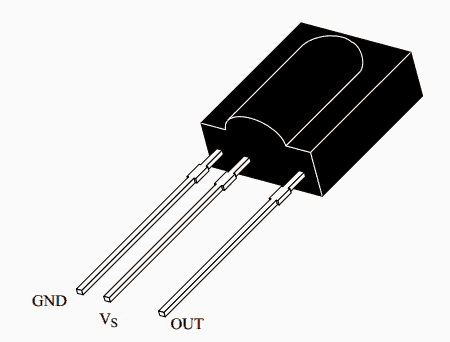
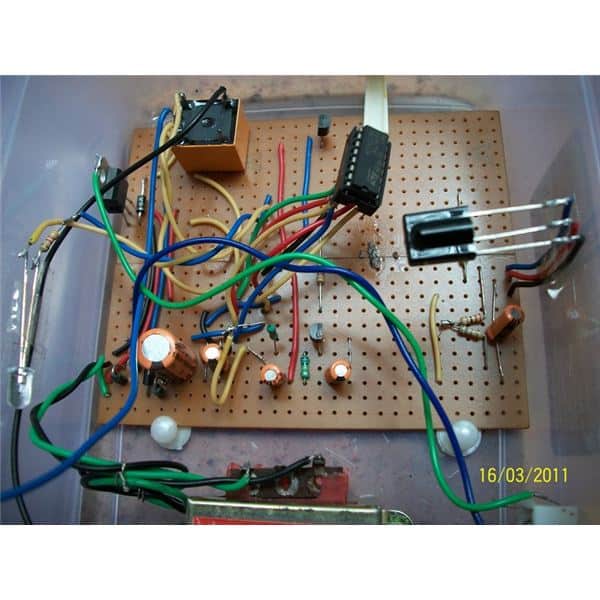
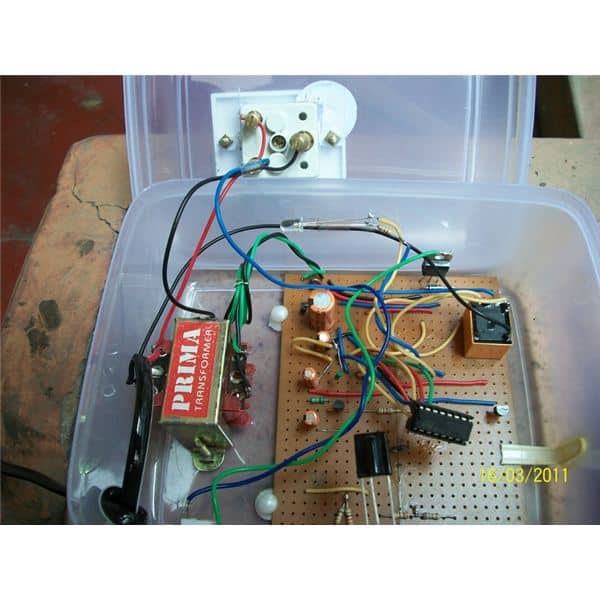
Prototype image courtesy: Raj Mukherji
2) Precision Infrared (IR) Remote Circuit
The second IR remote control circuit discussed below uses a unique frequency and detects only the specified IR frequency from the given remote transmitter unit, making the design entirely failproof, accurate and reliable.
Ordinary IR Remote Drawback
Ordinary IR remote control circuits have one big drawback, they easily get disturbed by stray external frequencies, and thus produce spurious toggling of the load.
In one of previous posts I have discussed a simple IR remote control circuit which operates quite well, however the circuit is not completely immune to external electrical disturbance generations such as from appliance switching etc. which results in false operations of the circuit causing lot of annoyance to the user.
The circuit design included here efficiently overcomes this problem without incorporating complex circuit stages or microcontrollers.
Why LM567 is Used
The solution comes easily due to the inclusion of the versatile IC LM567.
The IC is a precise tone decoder device which can be configured to detect only a specified band of frequency, known as passband frequency.
Frequencies not falling within this range will have no effect on the detection procedures.
Thus the passband frequency of the IC may be set precisely at the frequency generated by the transmitter IR circuit.
Shown below are the Tx (transmitter) and the Rx (receiver) circuits which are set precisely to complement one another.
T1 ad T2 along with R1, R2 and C1 in the first Tx circuit forms a simple oscillator stage which oscillates with a frequency determined by the values of R1 and C1.
The IR LED1 is forced to oscillate at this frequency by T1 which results in the transmission of the required IR waves from LED1
As discussed above, R5 of IC2 in the Rx circuit is adjusted such that its passband frequency precisely matches with that of LED1 transmission output.
Circuit Operation
When the Tx IR waves are allowed to fall over Q3 which is an IR photo transistor, a subsequent order of varying positive pulses is applied to pin#3 of IC, which is basically configured as a comparator.
The above function generates an amplified output at pin#6 of IC1 which in turn gets induced across the input or the sensing pin out of IC2.
IC2 instantly latches on to the accepted passband frequency, and toggles its output at pin#8 to a low logic level, triggering the connected relay, and the preceding load across the relay contacts.
However the load would stay energized only as long as Tx stays switched ON, and would switch OFF the the moment S1 released.
In order to make the output load latch and toggle alternately, a flip flop circuit will need to be employed at pin#8 of IC2.
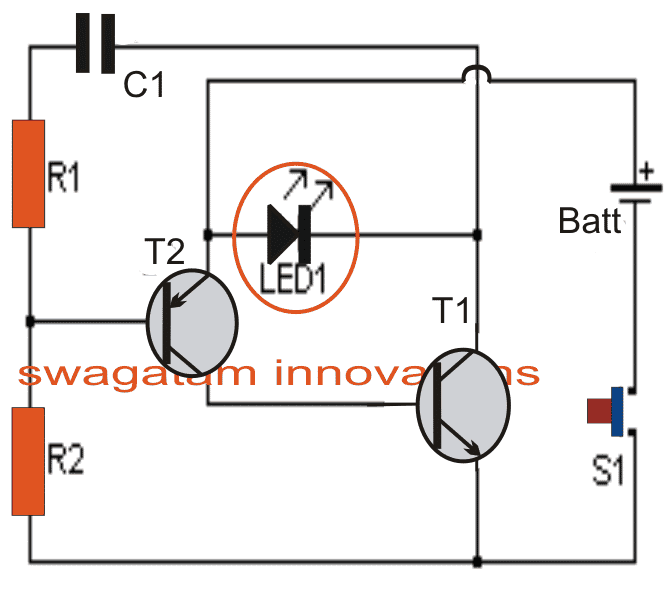
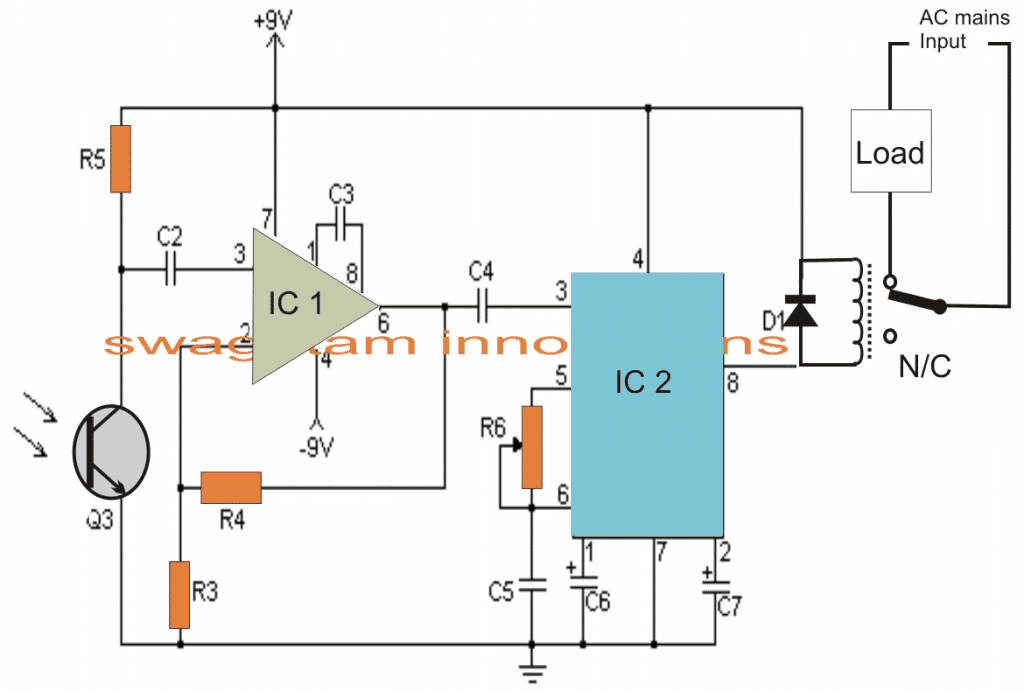
Parts List
- R1 22K 1/4W Resistor
- R2 1 Meg 1/4W Resistor
- R3 1K 1/4W Resistor
- R4, R5 100K 1/4W Resistor
- R6 50K Pot
- C1, C2 0.01uF 16V Ceramic Disk Capacitor
- C3 100pF 16V Ceramic Disk Capacitor
- C4 0.047uF 16V Ceramic Disk Capacitor
- C5 0.1uF 16V Ceramic Disk Capacitor
- C6 3.3uF 16V Electrolytic Capacitor
- C7 1.5uF 16V Electrolytic Capacitor
- Q1 2N2222 NPN Silicon or Transistor 2N3904
- Q2 2N2907 PNP Silicon Transistor
- Q3 NPN Phototransistor
- D1 1N914 Silicon Diode
- IC1 LM308 Op Amp
- ICIC2 LM567 Tone Decoder
- LED1 Infa-Red LED
- RELAY 6 Volt Relay
- S1 SPST Push Button Switch
- B1 3 Volt Battery Two 1.5V batteries in series
- MISC Board, Sockets For ICs, Knob For R6,
- Battery Holder
Another Simple LM567 based IR Remote Control Circuit
The next accurate LM567 based IR transmitter/receiver circuit ensures that the remote control can be operated only through a preset fixed frequency, and will not operate through any other unknown frequency.

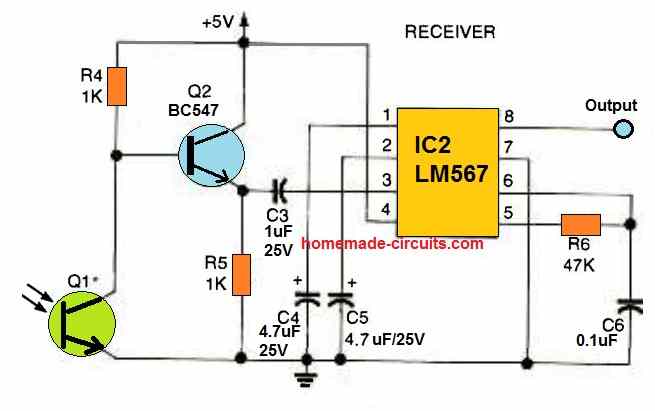
The transmitter circuit shown above produces IR light pulses through LED1, with a 320 Hz frequency (set by R2).
This frequency is focused at the phototransistor Q1 of the receiver circuit. This causes the phototransistor's collector to oscillate at the same 320 Hz frequency.
This frequency is boosted by the BC547 transistor and applied to the input pin#3 of the IC LM567.
The LM567 detects the 320 Hz signal as soon as it reaches the phototransistor, which instantly causes the output pin#8 of LM567 to turn low.
If the pulses of some other frequency is focused to the phototransistor, the LM567's output stays high and unresponsive, because it is calibrated to respond only for 320 Hz (as set by R6).
If you wish to operate the remote control with some other frequency, make sure to use identical values for R2 and R6, so that the transmitter frequency matches the receiver's detection frequency.
Remember that the LM567 operates between 100 Hz and 1 kHz and the detection frequency range must not be selected beyond these limits.
A multi-channel remote control system may also be created by substituting R2 with additional number of resistors (for multiple frequencies) and LM567s set to the desired frequencies.
Switching an Output Load
If you want to switch an output load ON/OFF at pin#8 of the LM567, you can do it by integrating a 4017 IC flip flop circuit with pin#8 of LM567.
To implement this you just have to integrate the following 4017 flip flop relay circuit with pin#8 of the LM567 circuit explained above.
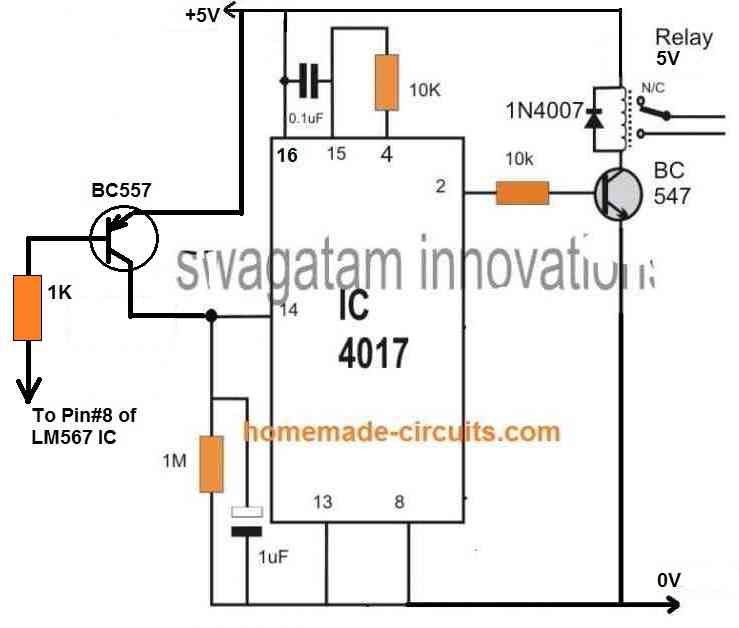
Simple Infrared Receiver using IC 741

Infrared Remote Control Circuit using IC 555 and Transistors
Here's a straightforward infrared switch designed for remote control purposes. It utilizes a typical IR LED and IR diode detector pair, specifically the CGIY89A/BPW50 components.
Transmitter Circuit

The 555 IC based IR transmitter circuit generates a series of pulses to drive the IR LED.
IR Receiver
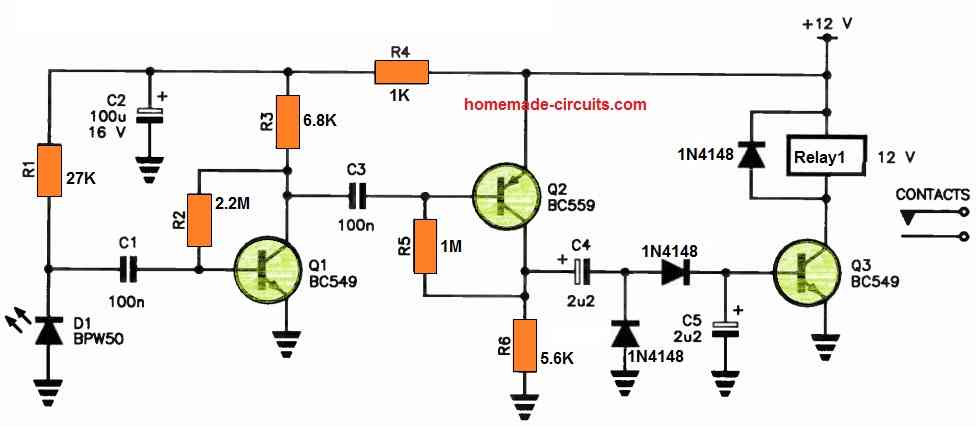
These pulses are then picked up by the IR receiver circuit through the BPW50 IR sensor and subsequently amplified by a high-gain amplifier, employing Q1 and Q2.
The output from Q2 undergoes rectification via a voltage-doubler rectifier, which supplies the base current required for the relay driver, Q3, ultimately enabling relay operation.
The transmitter is enclosed within a compact handheld enclosure, powered by a 9 V transistor radio battery.
In contrast, the receiver is powered by a 12 V DC source, such as a plug-in adapter. It's worth noting that all the components used in this setup are readily available at electronics retailers.
Transmissor de infravermelho com ci4047 list peças, please. Thank you , Brasil.
I cannot see any 4047 based circuit in the above article??
Hi!
I’m trying to make an IR-gate with TSOP38438 and TSAL6200. The receiver is an Arduino Nano with direct input from the receiver and the system works fine. The transmitter is made with Arduino Nano and 2222A that drive the IR-LED. Power for driving the LED is taken through voltage regulator with 5V output and Arduino is fed straight from 12 V battery. This as such works also fine. irRemote with NEC is used for send/receive.
The problem is that for some reason I can only get a working distance of 6-8m outdoors during daytime and 11-13m when dark. With a normal TV remote (several different ones tested) I get easily distances of 20m daytime and 40+m when dark. The TV remote uses two AAA-batteries/2,8V while I’m using 5V. Changing resistors to smaller does not seem to help. Neither did placing a 100 nF capasitor between regulator +/- and regulator 5Vout/-.
What could be causing this differece in distances? Is it just distorted signal from arduino or something else?
Hi, are you using a precise 38kHz frequency from the Arduino for activating the TSOP38438?
I’m using what ever comes with irRemote library’s NEC code, for which according to Wishay the receiver should be specially well suited… What ever that means. I’ve not set the frequency manually.
One thing I forgot to mention is that I’m using a bread board as a test base. I’m suspecting it might be causing some distortion on the signal.
Yes, possibly the breadboard can introduce distortion; otherwise, there is no apparent reason why a TV remote would have a greater range than your Arduino circuit.
Can any of the mentioned sensors detect human body radiated IR waves?
For human detection you can try the following circuit:
https://www.homemade-circuits.com/pir-burglar-alarm-circuit/
Spoke too soon!!!! C2 is needed to insure better response. Thanks!
That’s correct!
Hi Swagatam! What is the purpose of C2 and C6 in the first circuit? I have built this circuit and it works with C2 and C6, but it has a long delay on start and a long delay on stop. I removed C2 and C6 and it works better for my situation.
Hi Norman, these capacitors are used to stabilize the input pulse frequency from the IR sensor and prevent the 4017 IC from behaving erratically. Yes these components might create some delay so you can reduce the values of these capacitors appropriately to minimize the delay.
How did you arrive at the choice and size of components used? I need calculations
For the circuit with tone decoder,
(1) how can I calculate the right frequency using R1 and R2 that will operate the receiver. The formula.
(2) I observed that my room LG TV remote can’t operate my LG DVD and my parlour Philip LED TV remote can’t operate my room LG TV maybe because they transmit at different frequencies. So can’t I use TV or DVD remote and tune the receiver circuit to the remote frequency instead of assembling transmitter
(3) for the cd4017 based control, will it be possible to configure the circuit so that the relay will only operate when it receive five remote-press, that is ON-OFF-ON-OFF-ON, then the relay will switch just like double clap circuit, to avoid external unwanted sign from having influence on the circuit?
(4) what is the maximum range or distance for the receiver circuit to get the signal from the transmitter?
(5) for the transmitter circuit given, does the signal strength has the ability to penetrate wall, because I will like to incorporate it to generator remote start/stop, Gen/Mains ATS, so that it will operate
You can calculate the frequency using the following formula:
fo ≃ 1 / (1.1 × R6 × C5)
where
• R6 = Timing Resistor
• C5 = Timing Capacitor
2) No, TV remote cannot be used for the LM567 based circuit.
3) The 4017 cannot be disturbed with eternal disturbances. It will never operate unless you press the remote control button. 5 times pressing can make the circuit very complex, that will require two 4017 circuits to be integrated with each other.
4) The first circuit’s range is above 4 meters. For the second circuit it can be around 1 meter.
5) IR signals can never penetrate walls or opaque obstacles.
Thanks for your response. Please can you give me the circuit for the 5 times pressing using CD4017, because the children can press it easily if it is one press. I don’t want them to know it’s 5 pressing, so that when they press the remote once or twice or thrice, the receiver won’t respond. Beside, one can mistakingly press the remote once and then receiver will respond if it is not 5 times pressing
Actually you can do it with a single 4017 IC in the same circuit. But there will be a problem. If somebody else presses the remote for say 3 times, then the remote will remember the 3 pressing of the button. Then subsequently if somebody presses the button twice the load will be activated. So if somebody presses the button for a few times it will not reset back to zero after the remote is left unused.
You can try the following circuit for the 5 times press ON/OFF.
Whenever you want to reset the circuit just switch OFF the power and switch it ON back…..the circuit will reset to the start point. The LED at pin#3 will indicate the start point.
Ok. Thanks so much. I will put it to practical
my name is christian am from nigeria .in think u need transmitter an receiver an u also need switch an two or more sensor bub an capacitor an power button for controlling the receiver part an u also need two motor engine I don’t no if u get me but is difficult to explained more about that is some that I can show u how I do it thank u an u also need battery an transformer
yeah it work perfect it can also control any type of project if u want it be it work perfectly thank u
Thank you very much for your valuable feedback. Much appreciated!
Hi mr swagatam am faith from nigeria.can tsop1838 be used instead of the mdntioned tsop1738 as it(tsop 1838) is the only available sensor in the local market near me?d
Hi Faith, yes it can be used.
EXELENTES TODOS SUS PROYECTOS Y MUY UTILES GRACIAS POR ILUSTRARNOS CON SUS CONOCIMIENTOS DE ESTA HERMOSA CIENCIA CUIDESE MUCHO POR FAVOR SALUDOS DE GUADALAJARA MEXICO
de nada, agradecemos sus comentarios
Dear Swagatam,
The hobby projects innovated by you are really excellent. However, I am very much interested in the remote control fan and light. Would you kindly let me know any circuit diagram in which one fan ( including speed control) and one light ( ON/OFF) can be controlled.
I shall be highly obelized for your early reply.
Regards,
DK Ghosh
Thank you Dear Dilip,
Light ON OFF can be controlled using the circuit explained above. I have yet to test and verify a, IR remote controlled fan regulator circuit which I may do soon. Once I test it I’ll post it in this website for you and others.
Hi Swagatam,
I have successfully built this circuit and it is working perfect. thanks for that. I have an issue like others will have. the TSOP1738 is picking up any remote key pressed which is making not acceptable for any home appliances because In same room I use my TV, AC and many other remote controlled devices and this is picking up signals from any remote with any key press. Can you please suggest some additional circuit for it to only pickup the signals from specific key from remote. I am also good to make a transmitter for this too.
Hi Saqib,
To correct this issue you may have to modulate the 38kHz frequency from the remote with another frequency and then use an intermeiate LM567 IC based circuit to detect this modulated frequency, this will allow you to get a intended unique frequency operation, if possible I’ll try to update the design soon in my website
wow that would be great. I am waiting for your new design and will continue upgrading this circuit using your guidance. Thanks Swagatam I appreciate your response.
sure, if possible I’ll try to do it soon..
whenever you do it. just drop me a message on saqib.lodhi@hotmail.com to check it on your blog.
OK, I will try!
Can I use this for TV ,ac ext…
Sir
Can I use this TV, ac, and ext..
yes definitely you can…
hello sir ,
in this will a 6v relay work or i will have to get a 12v relay.
hello siddarth, your relay voltage must match the available supply voltage value, or you can use a supply source in accordance with your relay specs….but both must be approximately equal.
however 5V can be used for operating a 6V relay, therefore you can use the 5V from the 7805 for supplying the relay also
what is the value of c3 is any special importance to c3
john
it's 0.1uF, for decoupling the IC supply pins, and prevent incorrect switching of the IC during power switch ON
sir i assembled the circuit on breadboard only
john
good day sir
i have assembled the circuit. instead of relay i used a led from pin no 2
i found the light is flickering continuously, when i press the remote i can see the light flikering more so i am concluding that the circuit detecting ir signals .but how to make it stable so that i wll be able to connect the relay
i have did all the modifactions u mentioned in the above comments
still its not getting stable
thanking you
john
john
Good day John,
did you try increasing the value of C6? increase it to 100uF and see the response. if still it's flickering then definitely there's some other fault in your circuit or may be the IC 4017 itself is faulty.
I cant see circuit diagram, can anyone share with me. Please.
use a proxy site….
We are Pakistani… 😀
Thank you sir your reply was helpful, what if i want to use both the 5v and mains supply? When there is power outrage and i might want to use the 5v battery so how do i go about it. And pls sir specify the kind of tv remote that would suit it.
for that you just have to connect the positive of the 5V battery with the output of the 7805 IC through a 1N4007 diode, cathode will connect with the 7805 output and the anode with the batt positive….the negative of the batt will connect with the negative line of the circuit
all and any TV remote should work with this circuit
Pls instead of using the rectificaton section can't i just use a 5v dc battery? And how do i connect it to the load?
you can use a battery, but battery will get discharged at some of time, that's why a mains operated power is recommended.
the relay contacts and the load wires which are shown connected with the mains will need to be connected with the 5V supply
Is there anybody who can provide a picture of their prototype ?
The ones presented in this article are not quite what regular hobbyists would expect.
Seriously, I do understand that this was created by someone with minimal experience, nevertheless any projects with parts floating in the air like that, should be advised that this is not a good practice.
For the sake of everyone, a "cleaner" prototype would be appreciated.
Sir i cant understand the above names and components so can i have a video with explaining and making of above activity clearly
Akula, I would suggest that you first learn the basics of electronics and regarding all the electronic components before building any circuit idea, otherwise you may find it extremely difficult and might not succeed.
Hi sir i am an 9 class student i want to do a project which is to control lights with remote so plzz explain me the above in easy and in regular language so i can do it very ease plzzz sir
Akula, I have explained all the details in the article already, if you have specific questions you may ask them, I'll try to answer.
Plz tell me all the 12 v relay connections sir.. M stuck there.. its not working..
connect the relay coil with the transistor and positive….relay pole contact can be seen connected with the load, and either the N/O or the N/C contact may be selected and connected with one of the mains input, as indicated.
Sir in the pic the ic2 is connected with a green wire.. Confused abt that and where does the green and blue wire leads to??
probably those are terminated out through a headphone jack for allowing the 5V to be accessible through the jack for some external DC circuit.
Thnk u sir …sir where to put the leds….nd what to do with the earthing connection. ..should i leave the earthing or we have to earth them..
Aryan, you can put the LED in series with R4. The earth symbol represents the negative supply line of the circuit, make sure you connect all the marked points together with the negative supply line of the circuit
Sir will it work in 10 volt adapter?
relay coil voltage should match the adapter voltage, in your case the relay should be also 9V rated
Sir plz specify the relay nd its value..
Hello, i made this circuit with a 6V relay ( i dont have 5v ) , but it d'ont work at all !!!!!
pls help :
topo.science@yahoo.fr
thankssss
connect a red LED in series with the transistor base and first confirm whether or not this LED is responding ON/OFF with remote control button press…if not then there could be something severely wrong in the connections.
When i connect a led in the base of transistor the led not flash when I push remote button !!
check voltage across T1 base and emitter by keeping the black prod of meter at base, and red prod at emitter, and simultaneously by pressing the remote handset button, it should change from 0 to 0.6V….if not check the same across the sensor output pin and supply pin….confirm this first
Enter your comment… thank you for your Quick response ,its kinda working but there is still s problem its changes the state of the load just three times and would stop to work but when i unplug and replug its still repeat same three time and pause.pls help me. its urgent
ojodarlinton@gmail.com
did you connect pin#4 with pin#15??
anyway just try changing the output pin configuration of the IC 4017 exactly as done with the circuit in the first diagram of this article:
https://www.homemade-circuits.com/2014/05/remote-control-circuit-for-multiple.html
its responding very slow. when i plug it the load comes on and when i press the remote button its goes off but when trying to put it on again it wouldn't until Upton 2mins before its responds.pls what should i do?
reduce C2 value to 10uF/25V and check…..
In your circuit dia. the negative leg of C2 is connected to Vout of the IRS. Since C2 is a polarized cap., should it not be connected to ground instead?
C2 is placed across base/emitter of T1 in order to stabilize the T1 response….so it's fine.
Hii sir .,
i assembled this circuit but it didn't work pls hep me sir……
can u tell me an circuit diagram for drone so that it can fly easily to control its 4 motors
possibly I may try to publish one using RF remote control….
Hi, Can I use it to operate more than one relay at the same time by using other outputs in IC4017. Do I need to change the current rating of the transformer. Pls advise.
If you are interested to operate other relays in sequence one after the other by using the other outputs of the IC, then you can still continue to go with the same circuit because each relay would be operated individually and never together so there wouldn't be any increase in the current consumption during those operations
Hello sir….
I hv another question…
In previous comments.. You said about TRANSFORMER that it stepdown 220v to 12v.
If i put directly 12v adaptor… Then it work or not???
hello saurabh,
a 12V AC/DC adapter will also do…
Hello sir….
You have a timer curcuit for mobile charger or etc..
If i set the timing for 3 hour then after 3 hour curcuit stop the charging…. Or until curcuit will consume 3 hour electricity then it stop charging… Plz suggeste me this type of curcuit..
Because overloading the battery will decrease life of battery.. So plz
Hello Saurabh, all cell phones have in-built sophisticated over charge cut off circuit so there's nothing to worry, the battery will never get overcharged even it's kept connected to the charger forever.
Hello sir…
In your part list ..
You didn't specify the value RELAY..
PLZ suggest me… Value of RELAY
If your transformer is 12V, the relay can be also a 12V (coil voltage) with N/O and N/C contacts
Hello sir…
1. What is the use of TRANSFORMER in this curcuit.
2. Is this work on any T.V and setop box remote?? And which button is responsible for sending signals to receiver curcuit..
Hello saurabh,
transformer is for stepping down the mains 220V to 12V.
yes any standard IR remote handset should work with the circuit.
sir if i remove the "out" terminal of sensor from R3 the voltage fall from 3v to 0v with out i press a remote
point and press the Tx at the sensor and see if it produces any changes in potential at the "out" pin, if it doesn't would mean the sensor is faulty.
dear sir,
it does not show 0v on DMM when ever i press button it shows 2.9v constant sir . I use the sensor which is used in our tv it don't have any number but i connect its terminals as TSOP1738 irs sir
disconnect the output of the sensor from R3 and then check, if still it continues to be the same you can assume the sensor to be faulty or wrongly connected.
If it works correctly would indicate a wrongly connected T1 or a faulty T1
dear sir,
2.9v at sensor "out" terminal and 1v at the "Vs'' .It does not show 5v initially sir please tell what is the problem
please check the response with a IR transmitter, as explained in the pervious comment.
you can connect an LED in series with R3 for getting indications regarding the switching.
cathode of LED will go to R3, and anode to base of the transistor
Dear sir,
intially it shows 2.8v sir
point and press a TV remote control at the sensor, and check the voltage response at the output of the sensor..it must become zero or almost zero…. if not your sensor may be faulty or not connected correctly.
I didn't got 5V relay so I used 12V, but it not on and off why?
dear sir,
i connect the irs as shown in diagram but it is not working.sir please tell me the voltage or current across the components and is their any problem if relay inputs are change. how i check the relay whether it is working or not
Dear Ani,
first make sure the sensor pinouts are connected correctly.
Next, confirm the voltage across it's (+) and GND pins, should be 5V as per the circuit.
Once you have confirmed the above take a DMM set at DC voltage range and connect its red prod to the "OUT" terminal of the sensor and black to the negative line of the circuit. Initially it should show 5V, but should respond with a zero volt or a lower voltage than 5V whenever the external IR remote is activated on it.
Please first confirm the above.
dear sir
i connect circuit as shown in diagram but it will not working. sir ir sensor have a 2 terminals but in diagram it have 3 terminals. so i can not connect the irs to gnd and where i connect the remaining pins of ic 4017 please tell me sir
dear ani,
you must use the one that's referred in the diagram.
see the prototype images for getting the idea of the sensor type and appearance
Hii sir is there any possibilities of using a transformerless circuit for this circuits power supply? I know its critical but I want to makes rhings more compact in a box thank you. 😀
Hi Srishan, you can try the one that's shown in the following article:
https://www.homemade-circuits.com/2011/12/cheap-yet-useful-transformerless-power.html
put two zeners in parallel if possible for better safety.
use 15V/1watt zeners
Sir, in the remote control circuit the feed is only 230Vac.What will be the relay rating?In this circuit there is no need of any external DC supply.Please help.
Partha, the power supply is clearly shown at the top section of the circuit using a transformer, bridge network….the green color box is the relay coil.
Sir ,this means the relay will work in 12V dc which will be fed from step down transformer and the bridge.Please help me to understand .Thanks.
yes that's correct
Sir, one more doubt about the value of R4 .Is it 4K7?
yes it's 4k7 = 4.7k
Sir, in the design you have used a relay.What kind of relay is it?And what is the source of supply?
It's 12V, 400 ohms, SPDT, you can see it in the image below. the square orange colored block is the relay
hi Swagatam ,
i want to make "remote controlled switch board" through which i can operate 4-5 appliances bye remote control. so please suggest me circuit diagram with detail.
Hi Abhishek,
You will see this circuit soon in my blog….keep in touch
thank u sir,
i wil follow ur posts.
Sir ,
can i have circuit diagram for 'REMOTE CONTROLLED SWITCH BOARD' . through this i can operate 2 lights , 1 fan, 1 AC, 1 TV.
Hi Swagatam,
As Parthi Ban quoted the requirement of many loads, is it possible to use uC for the same? But for that we need to diagnose which button on Remote was pressed, can we detect that? (using the circuit you provided or any other).
What's the difference between IR and RF wireless communications? (w.r.t. the current purpose).
I definitely want to use uC, please suggest which one should i choose. say for controlling a minimum of 6 loads.
Can you help in uC also?
Anyways great job Dude !!
Hi Rahul,
Thanks!
A uC may not be needed for controlling more loads, it can be done by using separate receivers for each load and with a transmitter handset having individual buttons, just as we have in TV remotes.
I would be addressing one such design soon in my blog.
IR is Infrared and Rf is Radio frequency, IR cannot pass through walls, Rf can.
Sir, can you please suggest a circuit for the below mentioned purpose.
"Current must flow in one direction and the amount must be controlled by a regulator (like in ceiling fans). And on moving the regulator in another direction the current must flow in another direction."
Sorry Stavan, the given data is not sufficient, pls provide more precise information
HI swagatam ….
please help me .. is that a 12v relay or a 5v relay..
Anuj, it's a 12v relay
hai sir i want to control many load pls help me sir
with the above simple design only one load can be controlled.
sir i need a relay range
hi sir…i am girish. i didn't get the phototransistor TSOP 1738, but in my area TSOP1838 is available .can i use that here…but i didn't get the pin configuration on internet…so can you help me???
Hi GR, you can use it in the above circuit,
pin2 is ground, pin1 is output and pin3 is Vs(supply)
the image is shown, hopefully it's correct:
http://www.fact4ward.com/blog/wp-content/uploads/2012/08/tsop1838.gif
sir plz sort out my project …………..
yes, but there shouldn't be any obstacle in between….
i have made this circuit. everything is well i tested, but tsop. the output still high even i press remote to it…. everytime i power it on. the relay active (connected to pin 2 of 4017). what wronge sir…please help..!
connect a 10k resistor between pin4 and pin15 and connect a 0.22uf or any close value cap across pin15 and positive…see if it helps.
i found the problem sir..when i test the circuit without tsop1738. it works well. so, i try to replace tsop1738 with tsop1138. it works well even under day light or cfl lamp. i use it to control the 220v 1500w chickent washing machine and work with only a cheap cell phone charger as power supply..it is very useful sir…thank much.
OK great, thanks!
don't have much idea about PICs, sorry….
I am sorry, I don't have much idea about the concept.
sir,plz give us a simple mini project of optical communication .. i am waiting for ur rply.. thanks…
Hi Maria, pls provide full details of your project requirement, I will try to help.
i'll try to find it
SIR PLZ GIVE ME A CIRCUIT WICH CAN FLASH 12 VOLT LAMP PLZ SIR
try this one:
https://www.homemade-circuits.com/2011/12/build-simple-how-to-build-universal.html
SIR PLZ GIVE ME A EASY FLASHING CIRCUIT VERY EASY PLZ
try this one:
https://www.homemade-circuits.com/2011/12/how-to-make-single-transistor-led.html
ok Sir no problem if it's beyond your reach… then sir give me a detail explanation of IR remote control working so that I can explain it in my presentation…the questions that may be asked from this topic, brief me about them in document type link. thanks
I have already explained it elaborately in the above article, if you have specific questions you may ask them, I'll try to clarify them.
Thank you so much Sir for your prompt reply 🙂 Sir,actually controlling light/fan/ac is somewhat easy but closing/opening doors, windows and curtains is not so easy, it will require motors and some complications will be involved for achieving this furthermore we have to include temperature/humidity and light sensors also. So i am confused how will I achieve all of this. Please guide me how should I start up. I have to implement my project using Micro Pro C, MP lab, Proteus. And our project involves 3 main parts: 1)Communicate IR sensors with micro controllers. 2)Communicate wirelessly micro controllers with other micro controllers. 3)Communicate wirelessly motors with micro controllers.
Hopefully waiting for your help Sir.
You are welcome, I wish I could help you with all those stages, however the mentioned stages appear quite complex and are not within my easy reach, so I am sorry I won't be able to go beyond the IR remote control stage explanation.
Hello Sir, we have to make this IR remote control for receiving part in our final year project. Our fyp is "Room automation system for disabled persons" in which we have to control electronic equipments like light, fan,AC and non electronic equipments like door, curtain etc…. we have to open/close these mentioned equipments…. so can this remote control circuit given by you can be useful in our project??? please guide me and if any modifications needed, do tell about them. and can u give the code that is burnt in the controller ic in above circuit? waiting for your prompt reply anxiously… thanks. 🙂
Hello Maria,
Te above circuit is not so reliable. I'll recommend using LM567 IR remote circuit as shown below:
https://www.homemade-circuits.com/2013/03/simple-reliable-infrared-ir-remote.html
you can try the second circuit from this link:
https://www.homemade-circuits.com/2013/03/simple-reliable-infrared-ir-remote.html
how many mAh need for this circuit ?
100mA